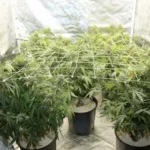Mastering cannabis plant training is one of the smartest moves a grower can make. Training your plants not only maximizes light exposure but also improves airflow, bud density, and overall plant health. Whether you’re growing indoors or outdoors, training methods can significantly boost yield without needing extra space or lighting.
Understanding Cannabis Plant Growth
Cannabis plants naturally grow in a Christmas tree shape, with one dominant cola at the top and smaller branches below. This structure works in nature, but for controlled growing, it’s inefficient. Lower branches get less light, meaning smaller buds. Training changes this growth pattern, spreading branches to create an even canopy where every bud site can thrive.
Types of Cannabis Plant Training
1. Low-Stress Training (LST)
LST is the gentlest form of cannabis plant training. By bending and tying stems, you encourage horizontal growth instead of vertical. This keeps the canopy level, allowing light to reach all bud sites evenly. It’s ideal for small grow spaces and causes minimal plant stress.
2. Topping and FIMing
These techniques involve cutting the main growth tip to encourage multiple colas. Topping produces two new main branches, while FIMing (short for “F*** I Missed”) results in several new shoots. Both methods increase bud sites but require a short recovery period.
3. Screen of Green (SCROG)
The SCROG method uses a mesh or trellis net to control growth. As branches grow through the screen, they’re trained horizontally to form an even canopy. This method maximizes light use and is perfect for maximizing yield in limited vertical spaces.
4. Super Cropping
A high-stress technique, super cropping involves gently squeezing and bending branches to slightly damage inner tissues. This stimulates the plant’s defense mechanisms, resulting in stronger stems and potentially larger buds. It’s an advanced method and should be done carefully.
5. Defoliation
Strategically removing excess leaves helps increase light penetration and airflow. When combined with other training methods, it can direct more energy to developing buds. However, too much defoliation can slow growth, so it’s important to strike the right balance.
When to Start Cannabis Plant Training
The best time to begin most cannabis plant training is during the vegetative stage. At this point, plants are flexible, recover quickly, and can adapt to shaping. Some light training, such as leaf tucking, can also be done in early flowering, but major bending or cutting should be avoided during this stage.
Essential Tools for Training
-
Soft plant ties or coated garden wire
-
Trellis netting or SCROG screens
-
Sharp, sterilized pruning shears
-
Plant stakes for structural support
-
Gloves for protection and hygiene
Tips for Effective Cannabis Plant Training
-
Be gentle when bending stems to avoid accidental breaks
-
Train plants consistently to maintain canopy shape
-
Combine multiple training methods for best results
-
Watch for signs of stress and allow recovery time
-
Maintain a clean grow area to prevent infections or pests
Mistakes to Avoid
-
Waiting too long to start training
-
Over-pruning, which can shock plants
-
Applying too much pressure when bending stems
-
Neglecting to secure branches properly
The Benefits of Cannabis Plant Training
By investing time in cannabis plant training, growers can enjoy:
-
Higher yields without bigger grow spaces
-
More consistent bud quality across the plant
-
Healthier plants with improved resistance to disease
-
Easier maintenance and harvesting
Final Thoughts
Whether you’re a beginner or an experienced grower, cannabis plant training can take your harvests to the next level. With simple tools, patience, and the right techniques, you can grow plants that produce bigger, denser, and more flavorful buds. Start small, practice regularly, and watch your yields grow.

